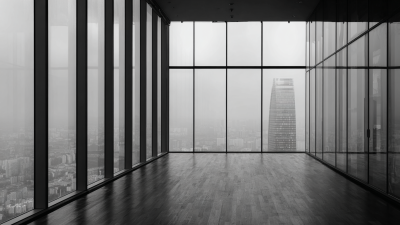As the demand for innovative designs and enhanced functionality in residential and commercial spaces continues to rise, the significance of Float Windows in modern architecture cannot be overstated. According to recent industry reports, the global market for energy-efficient windows, including Float Windows, is projected to reach USD 350 billion by 2027, reflecting a growing preference for aesthetically pleasing yet functional window solutions. LEAWOD Windows & Doors Group Co., Ltd. stands at the forefront of this evolving industry, offering high-quality finished windows and doors that cater to the needs of discerning customers.
The innovative design of Float Windows not only provides an unobstructed view but also enhances natural lighting, contributing to energy savings and improved indoor climate. As the inventor and manufacturer of R7 seamless whole welding windows and doors, LEAWOD integrates advanced technology and craftsmanship to deliver products that not only meet but exceed industry standards. This document will outline 10 essential tips for maximizing your experience with Float Windows, ensuring you make the most of their unique attributes while enjoying the long-term benefits they provide.

When it comes to maximizing visibility through float windows, it’s essential to understand their role in enhancing user engagement. Float windows serve as dynamic visual tools that can draw attention and drive interactions, reflecting the needs and behaviors of users in real time. Like effective strategies seen in various industries, such as optimizing release windows for television content, businesses can utilize float windows to schedule crucial updates or promotions during peak engagement times. This alignment ensures that users are not just passive observers but active participants in brand narratives.
Moreover, employing analytical tools can further enhance the effectiveness of float windows. By leveraging insights into user behavior and preferences, organizations can craft tailored experiences that resonate with their audience. This involves not just tracking interactions but anticipating needs, much like how e-commerce platforms have evolved to focus on customer journeys instead of merely sales metrics. Incorporating data-driven decisions into the management of float windows will significantly boost user engagement, akin to how strategic partnerships enhance productivity in document management systems. Ultimately, the goal is to create an engaging space where users feel valued and motivated to interact more deeply with content.
| Tip Number | Tip Description | Expected Engagement Impact | Implementation Difficulty |
|---|---|---|---|
| 1 | Ensure Float Windows Are Clearly Labeled | High | Easy |
| 2 | Choose Right Timing for Displaying Float Windows | Medium | Medium |
| 3 | Optimize for Mobile Viewing | High | Hard |
| 4 | Utilize Eye-catching Design Elements | Very High | Medium |
| 5 | Incorporate Interactive Features | High | Hard |
| 6 | Test Variations for Optimal Results | Medium | Hard |
| 7 | Limit Frequency of Float Windows | Medium | Easy |
| 8 | Ensure Easy Dismissal Options | High | Easy |
| 9 | Align with User Interests and Behavior | Very High | Medium |
| 10 | Monitor and Analyze Performance | High | Medium |
Float windows, or dialog boxes that remain on top of other windows, can significantly enhance user experience when designed effectively. According to a recent Nielsen Norman Group report, well-structured float windows can improve task completion rates by up to 28%. This emphasizes the importance of optimizing layout and design to ensure that users can engage with the content without distractions.
When designing float windows, maintaining a clear hierarchy of information is crucial. Utilize visual cues such as contrasting colors and font sizes to guide the user’s focus. A study by the International Journal of Human-Computer Interaction suggests that users are 42% more likely to complete an action when the primary call-to-action button is prominently displayed and distinct from other elements. Additionally, providing a close or minimize option that is easily accessible can reduce user frustration and encourage smoother navigation.
Incorporating these best practices not only enhances aesthetic appeal but also significantly impacts user interaction and satisfaction. A well-designed float window can act as a powerful tool, allowing users to multitask without losing context while keeping engagement high.
When utilizing float windows, understanding the importance of display duration can significantly enhance the viewer's experience. Timing plays a crucial role in maximizing engagement, as data-driven approaches show that longer display times can lead to increased retention and interaction. For manufacturers like LEAWOD Windows & Doors Group Co., Ltd., the integration of such strategies can facilitate effective communication of product features, ensuring potential customers fully grasp the innovation behind offerings like the R7 seamless whole welding windows and doors.
To further optimize float window effectiveness, it is essential to analyze viewer behavior and feedback. Short bursts of attention can be transformed into sustained interest by strategically layering content and adjusting the duration according to the context. Implementing analytics will provide insights into ideal display durations tailored to specific audiences, allowing LEAWOD to showcase its high-quality finished windows and doors in a manner that resonates deeply with dealers and customers alike. Leveraging these data-driven strategies ensures each interaction is purposeful and memorable.
 Float windows have transformed how users interact with applications, providing contextual information without disrupting the overall user experience. Insights derived from user behavior studies indicate that strategically placing float windows can significantly enhance engagement. According to a report by Nielsen Norman Group, users allocate approximately 90% of their visual attention to the area above the fold, highlighting the need for careful float window placement. A well-positioned float window can capture this attention effectively, offering timely information that increases user satisfaction and task efficiency.
Float windows have transformed how users interact with applications, providing contextual information without disrupting the overall user experience. Insights derived from user behavior studies indicate that strategically placing float windows can significantly enhance engagement. According to a report by Nielsen Norman Group, users allocate approximately 90% of their visual attention to the area above the fold, highlighting the need for careful float window placement. A well-positioned float window can capture this attention effectively, offering timely information that increases user satisfaction and task efficiency.
Moreover, user interactions with float windows reveal key patterns that can inform their design and deployment. Recent research conducted by the User Experience Professionals Association shows that 65% of users prefer float windows that are contextually relevant and unobtrusive. This suggests that designers should prioritize clarity and relevance in content delivery, ensuring that float windows not only enhance usability but also align with user expectations. By analyzing these behavioral insights, developers can optimize float window placement, leading to improved user retention and a more streamlined interaction flow within applications.
Float windows can be a powerful tool for enhancing customer engagement and conversion rates, particularly in the window and door industry where visual presentation is key. A/B testing provides an effective method to optimize the use of float windows by comparing different versions to see which elements resonate more with potential customers. By experimenting with varying designs, placements, and messaging in float windows, you can pinpoint which combinations drive higher conversion rates. For instance, showcasing LEAWOD's innovative R7 seamless whole welding windows with distinct call-to-action buttons or promotional offers can significantly improve audience interaction.

Incorporating A/B testing into your strategy not only enhances your float windows' effectiveness but also deepens your understanding of customer preferences. It allows you to tailor your visuals and copy to meet the market's demands, ensuring that high-quality products like LEAWOD’s finished windows and doors stand out. By continuously refining the presentation and functionality of your float windows, you'll be able to create a more impactful online experience that encourages conversions, strengthening your position as a leading manufacturer in the high-end window and door sector.
When implementing float windows, compliance considerations play a crucial role. According to a report by the International Association of Software Architects, nearly 30% of organizations encounter regulatory challenges during technology deployments. This percentage highlights the importance of thoroughly understanding relevant regulations that pertain to data privacy, accessibility, and user consent. For instance, companies utilizing float windows must ensure that they are compliant with the GDPR and CCPA, which set strict guidelines on user data management.
Furthermore, organizations must navigate the nuances of the Americans with Disabilities Act (ADA) when designing float windows for optimal user experience. A study by the Web Accessibility Initiative indicates that accessible design can enhance customer satisfaction by 20%, ultimately leading to increased conversion rates. By prioritizing compliance with these regulations, businesses can not only mitigate legal risks but also empower a more inclusive environment that reaches a wider audience. Thus, integrating compliance strategies with float window implementations can significantly maximize user engagement while satisfying regulatory standards.
: Float windows are dialog boxes that remain on top of other windows, and when designed effectively, they can significantly enhance user experience by improving task completion rates by up to 28%.
Maintaining a clear hierarchy of information using visual cues such as contrasting colors and font sizes is crucial for optimizing float windows. This guides the user’s focus and aids in engagement.
Strategically placing float windows can significantly enhance user engagement. Users allocate about 90% of their visual attention to areas above the fold, making effective placement essential for capturing attention.
Well-designed float windows that are contextually relevant and unobtrusive can increase user satisfaction and task efficiency as they deliver timely information without disrupting the user's experience.
Compliance with regulations such as GDPR, CCPA, and the Americans with Disabilities Act (ADA) is crucial. Organizations must ensure that float windows align with data privacy, accessibility, and user consent standards.
Float windows can enhance usability by allowing users to multitask without losing context, providing a smoother navigation experience and maintaining high levels of engagement.
Research indicates that 65% of users prefer float windows that are contextually relevant and unobtrusive, highlighting the importance of clarity and relevance in their design.
Non-compliance with relevant regulations can lead to regulatory challenges and legal risks for organizations, making it important to prioritize compliance in the design and implementation of float windows.
Implementing accessible designs in float windows can enhance customer satisfaction by 20%, which in turn can lead to increased conversion rates for businesses.
By analyzing user interactions and behavior insights, developers can optimize float window placement to improve user retention and create a more streamlined interaction flow within applications.
In the realm of digital user engagement, "Float Windows" offer a powerful tool for enhancing visibility and interaction. By understanding their impact on user behavior, businesses can strategically optimize the design and layout of these windows to create a more seamless experience. Key considerations include timing the display duration based on data-driven strategies and analyzing user interactions to determine the most effective placement.
Additionally, implementing A/B testing can lead to improved conversion rates, allowing businesses like LEAWOD Windows & Doors Group Co., Ltd. to refine their digital strategies. As a leader in high-end window and door manufacturing, navigating compliance considerations is crucial for the effective use of Float Windows in marketing efforts, ensuring that engagement strategies align with regulatory guidelines while maximizing user experience.











 +0086-157 7552 3339
+0086-157 7552 3339  info@leawod.com
info@leawod.com 